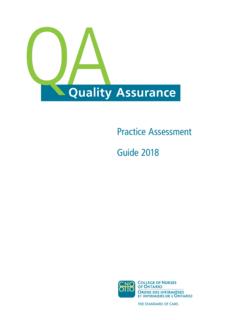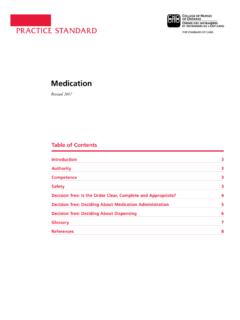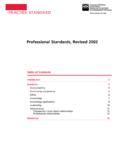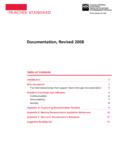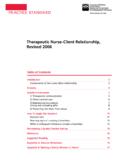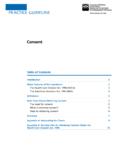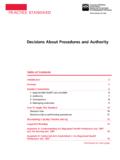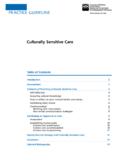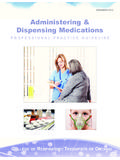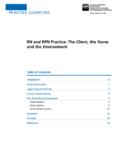Transcription of Legislation and Regulation An Introduction to the Nursing ...
1 FAC T SHEETFICHE D INFOR MATIONI ntroductionThe Nursing Act, 1991, along with the regulated health professions Act, 1991 (RHPA), determines how the Nursing profession is regulated in Ontario. The RHPA applies to all of Ontario s self- regulated health professions . The Nursing Act establishes the mandate of the College of Nurses of Ontario and defines the scope of practice for the Nursing profession. This fact sheet explains how the Nursing Act regulates registration (for example, classes of registration, entry-to-practice requirements, title protection), controlled acts (these are procedures that can only be performed by an authorized healthcare professional), quality assurance and professional misconduct. scope of practice for nursingEach profession has a scope of practice statement that describes what the profession does and the methods it uses. The Nursing scope of practice statement is: The practice of Nursing is the promotion of health and the assessment of, the provision of care for and the treatment of health conditions by supportive, preventive, therapeutic, palliative and rehabilitative means in order to attain or maintain optimal categories and classes There are two categories of nurses: Registered Nurses (RNs) and Registered Practical Nurses (RPNs).
2 There are several classes within each category. General Class Most of the College s RNs and RPNs are registered in this Class RNs in this class are Nurse Practitioners (NPs). They have met additional competency requirements beyond those required in the General Class. There are three specialty certificates in the Extended Class: NP-Adult, NP-Paediatrics, NP-Primary health Care (a fourth specialty certificate, NP-Anaesthesia, is not available at this time).Temporary Class RNs and RPNs in this short-term class are recent graduates, or applicants from outside the province, who have met all entry-to-practice requirements except successful completion of the registration exam. They practise as an RN or RPN subject to specific Assignment Class A short-term, non- renewable registration for RNs and RPNs, usually from outside of Canada, who have an appointment or assignment with an approved facility in Ontario.
3 They practise as an RN or RPN subject to specific Assignment Class RNs and RPNs, usually from outside of Ontario, are registered in this class when the provincial government has asked the College to issue certificates of registration in this Class Available to current and previous members of the College s General or Extended classes, members in this class are not allowed to practice, or represent themselves as qualified to practice, Nursing in to practiceApplicants must meet certain requirements to register as nurses in Ontario. For example, to register in the General Class, applicants must: successfully meet the Nursing education requirement provide evidence of Nursing practice successfully complete the national registration examination successfully complete the jurisprudence examination demonstrate they are proficient in either English or French provide proof of citizenship, permanent residency or authorization under the Immigration and Refugee Protection Act (Canada) to engage in the practice of Nursing in Ontario complete a Declaration of Registration Requirements protectionTitles used by nurses are protected under the Nursing Act.
4 This means that, in Ontario, only members of the College can use the titles of nurse, Registered Nurse, Legislation and RegulationAn Introduction to the Nursing Act, 1991 FAC T SHEETFICHE D INFOR MATIONR egistered Practical Nurse, or any variation, abbreviation or equivalent in another language. Only nurses in the Extended Class can use the title Nurse Practitioner. Individuals who refer to themselves as nurses or attempt to work as nurses in Ontario without being registered with the College are illegal practitioners and can be prosecuted under the Nursing Act a nd R HPA .Controlled acts authorized to nursingThe RHPA lists 14 controlled acts that are considered potentially harmful if performed by someone who isn t qualified. The Nursing Act authorizes nurses to perform the following controlled acts when ordered or permitted by the regulations pertaining to initiation: performing a prescribed procedure below the dermis or mucous membrane; administering a substance by injection or inhalation; putting an instrument, hand or finger: i.
5 Beyond the external ear canal ii. beyond the point in the nasal passages where they normally narrow iii. beyond the larynx iv. beyond the opening of the urethra v. beyond the labia majora vi. beyond the anal verge or vii. into an artificial opening in the body. dispensing a drug. treating, by means of psychotherapy technique, delivered through a therapeutic relationship, an individual s serious disorder of thought, cognition, mood, emotional Regulation , perception or memory that may seriously impair the individual s judgement, insight, behaviour, communication or social of controlled acts by nursesThe Nursing Act gives RNs and RPNs who meet certain conditions the authority to initiate specific controlled acts. This means they may independently decide if a specific procedure is required and safely initiate the procedure without a specific order or directive from a physician.
6 In some cases, the authority of RNs and RPNs to initiate may be limited by other Legislation or employer policies. For more information, refer to the College s Decisions About Procedures and Authority practice acts authorized to NPsNPs have the authority to perform the following controlled acts: communicating to a client, or a client s representative, a diagnosis made by the NP identifying as the cause of the client s symptoms, a disease or disorder. performing a procedure below the dermis or a mucous membrane. putting an instrument, hand or finger: i. beyond the external ear canal ii. beyond the point in the nasal passages where they normally narrow iii. beyond the larynx iv. beyond the opening of the urethra v. beyond the labia majora vi. beyond the anal verge, or vii. into an artificial opening of the body. applying or ordering the application of a prescribed form of energy.
7 Setting or casting a fracture of a bone or dislocation of a joint. administering a substance, by injection or inhalation, in accordance with the Regulation , or when it has been ordered by another health care professional who is authorized to order the procedure. prescribing, dispensing, selling or compounding a drug in accordance with the Regulation . treating, by means of psychotherapy technique, delivered through a therapeutic relationship, an individual s serious disorder of thought, cognition, mood, emotional Regulation , perception or memory that may seriously impair the individual s judgement, insight, behaviour, communication or social AssuranceThe RHPA requires that the College establish and operate a Quality Assurance (QA) Program that assists nurses to maintain competence and continuallyevaluate their misconduct regulationsProfessional misconduct for nurses is defined in the Nursing Act as an act or omission that breaches accepted ethical and professional standards of conduct.
8 For more information, refer to the College s Professional Misconduct read the Nursing Act, 1991, go to College of Nurses of Ontario, 2018410642018-28
